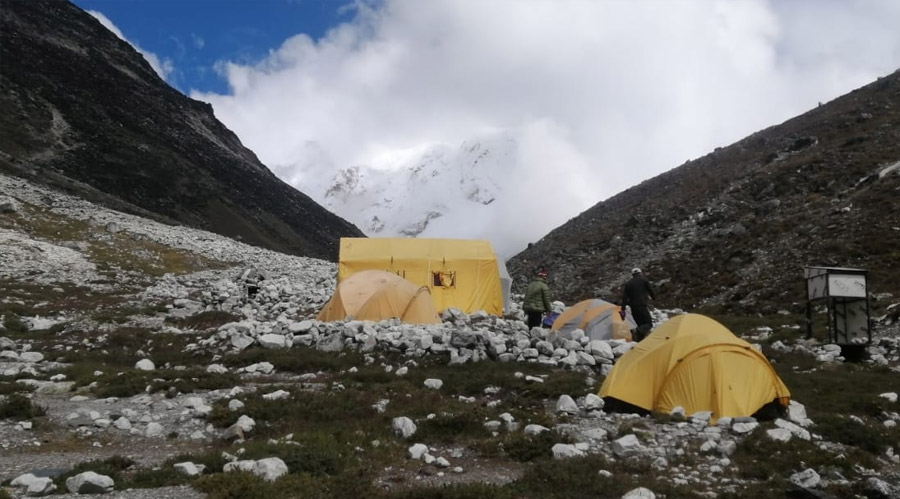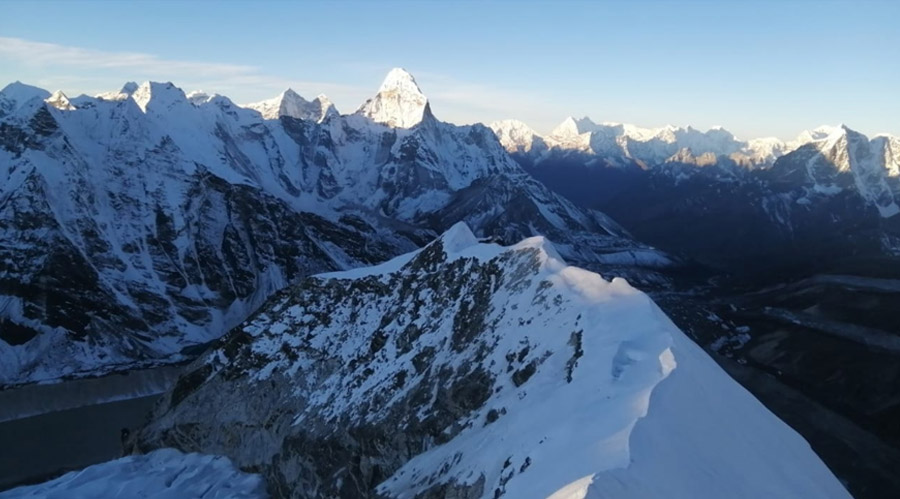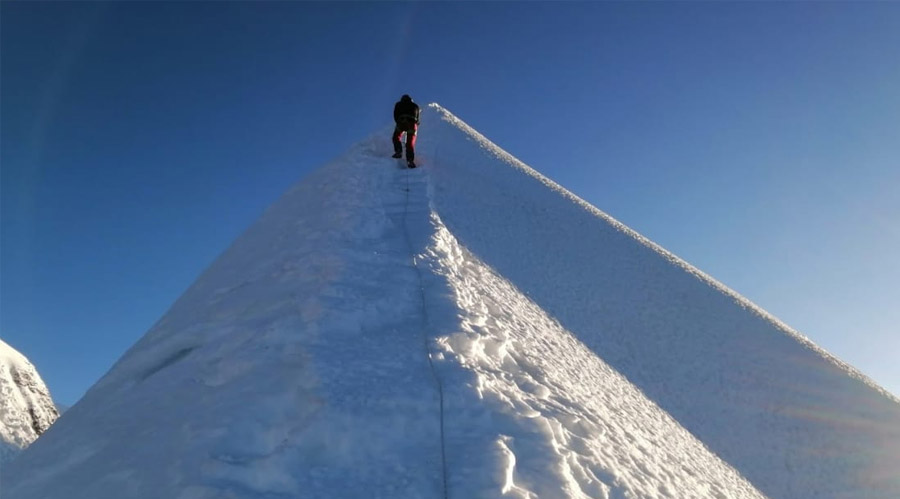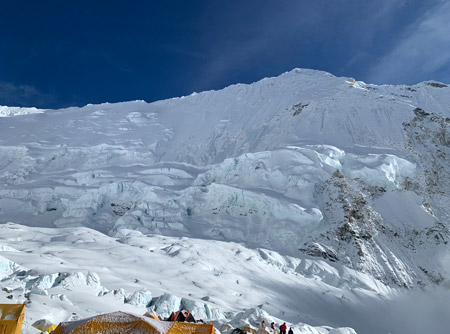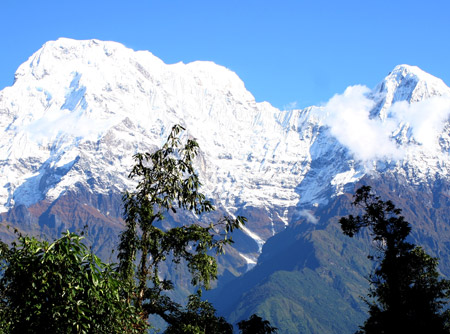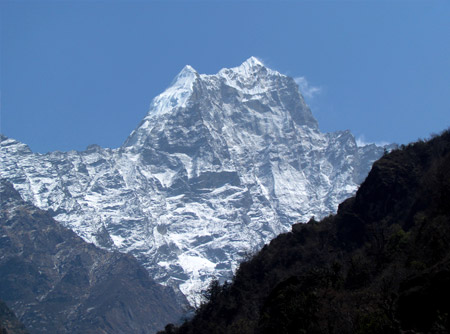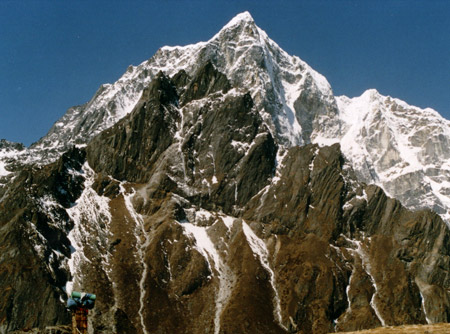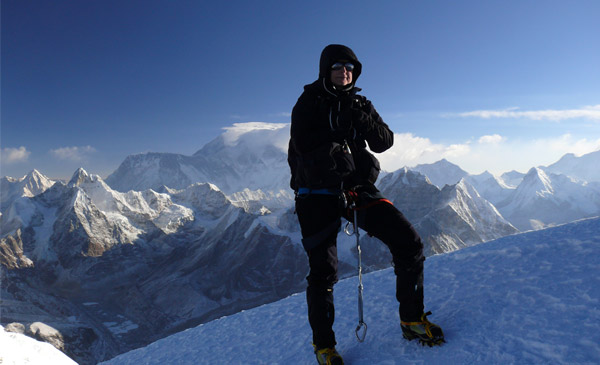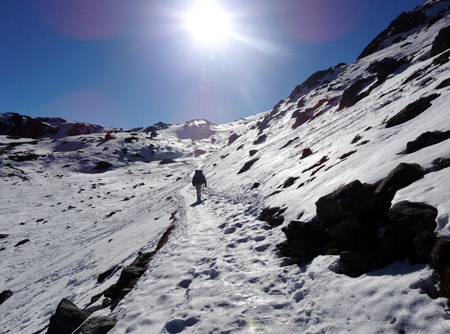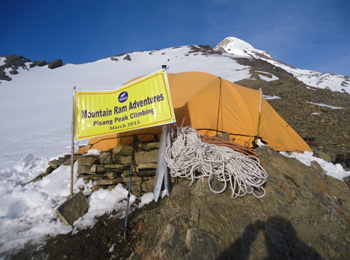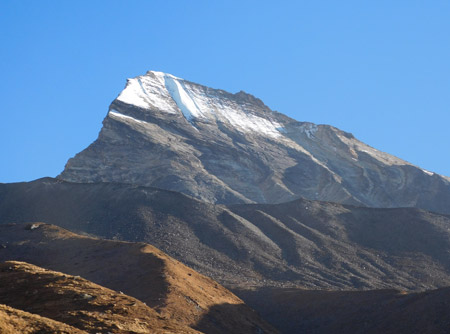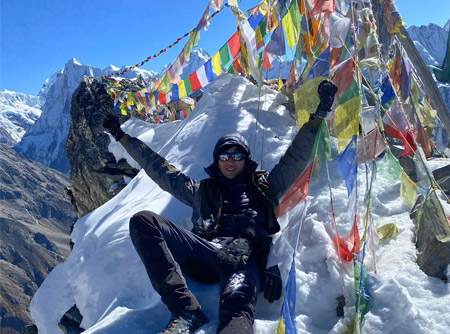- +977 9851074270
- info@mountainramadventures.com
Trip Highlights
- Perfect peak climbing introduction in the Himalayas of Nepal
- One of the best trekking peaks in Nepal for beginner climbers
- Trek to Everest base camp and Kala Paathar before the summit push
- Adventurous and exhilarating journey amidst towering mountains, remote Sherpa villages, and beautiful river valleys
- Spend nights in beautiful Sherpa villages and get to see their lifestyle and tradition
- Explore the abundant flora and fauna of Sagarmatha National Park in the lower part of the trail
- Cross glacial moraines, glacier paths, rocky trails, and steep uphill routes
- No technical climbing involved and learn basic climbing
- Unwind and enjoy the surreal mountain panoramas at the same time pushing yourself and testing your limits
- Short side hikes to Hotel Everest View, Nagarjuna Hill, Kala Patthar, and Chhukung Ri
- Witness majestic views of five eight-thousanders along with numerous other mountains
Detail About Island Peak Climbing with EBC
Go beyond trekking in Nepal and join our team on the 20 days Island peak climbing expedition in the Everest region. Embark on an exhilarating journey amidst towering mountains, remote Sherpa villages, and beautiful river valleys.
Island peak climbing is a beginner-friendly, affordable peak-climbing expedition in Nepal. Following our Island peak climbing itinerary, you will also trek to Everest base camp (5,364 m/17,598 ft) and Kala Patthar (5,545 m/18,192 ft), which will help in acclimatization. It is one of the most adventurous and daring ventures in the Everest region for trekkers who want to step their feet in peak climbing.
The Island peak climbing with Everest Base Camp is quite popular among adventure lovers. Island peak is not technically challenging, but the difficulty level is graded as Alpine PD+. It means climbing Island peak is very physically demanding. So even if you are a beginner climber, you have to be physically strong to do Island Peak Climbing with EBC trek.
Among all the trekking peaks in Nepal, Island peak is one of the best. The journey is thrilling and culturally enriching at the same time. You will be unwinding and enjoying the surreal mountain panoramas at the same time while pushing yourself and testing your limits. Away from the modern world, the Everest base camp with Island peak climbing lets you dwell in nature and untangle your thoughts.
Known as Imja Tse in Nepali words, the Island peak name was given by Tenzing Norgay and Edmund Hillary during their 1953 Mount Everest Expedition. Standing 6,189 m/20,305 ft from sea level, Island Peak is a stunning mountain to climb. The trekking part before the summit push will prepare your body and mind for the strenuous journey ahead. You will be meeting with locals and learning about their lifestyles simultaneously as you traverse the uneven trails.
We take two acclimatization days in between the trek and do three to four short hikes. Hotel Everest View (3,962 m/13,000 ft) and Nagarjuna Hill (5,100 m/16,732 ft) are two major acclimatization hikes along with Kala Patthar (5,545 m/18,192 ft). All these to get ready for the climbing part. Every day stores a surprise for you, and the landscapes only get better. The hiking routes are generally uneven and trodden.
Along with the five eight-thousanders- Everest (8,849 m/29,032 ft), Lhotse (8,516 m/27,940 ft, Kanchenjunga (8,586 m/28,169 ft), Cho Oyu (8,188 m/26,864 ft), and Makalu (8,463 m/27,766 ft), the trail offers views of numerous other mountains. Some of them are Ama Dablam (6,812 m/22,349 ft), Nuptse (7,861 m/25,791 ft), Pumori (7,161 m/23,494 ft), Kangtega (6,782 m/22,251 ft), Khumbila (5,717 m/18,757 ft), Thamserku (6,608 m/21,680 ft), etc.
Climb Island peak with EBC trek in Nepal
Before we climb Island peak, you will trek to Everest base camp and Kala Patthar. This hike will help you acclimatize before pushing towards a much higher altitude to the Island peak summit. So for the first nine days in the mountains, we will be trekking through Sherpa villages and lush forests.
The trek begins from Lukla (2,846 m/9,337 ft), and we will follow the usual route to Namche Bazaar (3,440 m/11,290 ft) via Phakding village (2,610 m/8,563 ft). In Namche Bazaar, we spend our first acclimatization days and then continue to Tengboche (3,860 m/12,660 ft). The trail then descends to Imja Khola and passes by Pangboche village on the way to Dingboche (4,410 m/14,470 ft).
The terrain gets steep and rugged beyond Dingboche. We will cross a glacier field to reach Dugh La and trek to Lobuche village (4,940 m/16,210 ft). After Lobuche, there is a small settlement called Gorak Shep (5,164 m/16,942 ft) before Everest Base Camp (5,364 m/17,598 ft). The following day, we will hike to Kala Patthar (5,644 m/18,519 ft) and descend to Dingboche, retracing the trail.
From Dingboche, we turn to Chuukung village (4,750 m/15,580 ft) and trek up to Island Peak Base Camp (5,200 m/17,060 ft), from where our climbing journey starts.
Pre-climbing training at the base camp
From the Island peak base camp (5,200 m/17,060 ft), we push to the summit (6,189 m/20,305 ft) the next day. It takes around 4 to 5 hours of walking to reach the Island peak base camp from Chhukung. So, we will have a lot of time to do climbing preparation and training. The lead Sherpa guide will give comprehensive training to boost your confidence before the summit push.
You will learn necessary techniques and climbing skills like using crampons and ice axes, rope management, glacier travel, and other safety equipment like harnesses and carabiners. We have both theoretical and practical sessions during the pre-climbing training.
The theoretical session involves the team leader explaining the basic principles of climbing, weather patterns, and altitude sickness. You will learn the safety guides for climbing, whereas for the practical session, we may walk up to a nearby glacier to practice the climbing lessons.
Summit day- stand at 6,189 m/20,305 ft in the Himalayas
The summit day on the Island peak is long and starts around midnight. We wake up between 2:00 AM to 3:00 AM and get ready to leave the base camp. It will be pitch dark, so we'll use headlamps. Leaving the Island peak base camp, we will scramble along a rocky ride to a glacier.
Then we will cross a snow headwall that leads to the summit. The climbing will be physically very demanding. The guides will secure the route and fix the ropes. Just before reaching the summit, we will climb 60 to 70-degree slopes about 150 meters tall. Do not forget, at this point guides will be either in front of you or behind you, so you have to do most of the rope work alone.
Once you are at the summit, make sure to keep your composure because the summit ridge is quite airy and has steep drops off to the sides. Enjoy your time at the summit, but be attentive. All you can see from this great height is numerous mountains and a sea of clouds.
Island peak climbing duration and tented camping
As per our Island peak climbing itinerary, we have two days for climbing along with a contingency day in case we see bad weather or any other disturbance before the summit push. From Chuukung village to Island peak base camp, it is a mix of trekking and climbing.
Our supporting crew will be at the base camp before we reach to set the camps. From here onwards, we will spend the next two days sleeping in tents and preparing our own meals. The supporting crew will take care of cooking the meals and other things, so you can focus on getting ready to climb Island peak.
The summit day is long. It takes around 10 to 11 hours to reach the summit and then return to base camp to spend the night.
Want to make the trip furthermore exciting? Add helicopter return from Chhukung or Island peak base camp
From the Island peak base camp or Chukkung, it takes 3 to 4 days to return to Lukla. If you wish to avoid this return trekking following the same path, you can add a helicopter flight from the base camp or Chhukung to Lukla or Kathmandu.
It is a great option if you are very tired and couldn't bother to do return trekking. The helicopter flight also makes the EBC with Island peak climbing more adventurous. You will get to witness the stunning aerial panorama of the mountains, lakes, and river valleys.
You can charter a private helicopter or a group flight as per your budget.
Island peak location and climbing history
Island peak is located in the Khumbu region, inside the Sagarmatha National Park, eastern Himalayas, Nepal. This peak is an extension of the ridge, coming down from the south end of Lhotse Shar. In 1953, this peak was named Island peak by the British Mount Everest expedition team because it looked like an island in a sea of ice from Dingboche.
Later in 1983, the peak was renamed Imja Tse in Nepali words, but Island peak remained a popular choice for westerners. The southwest summit of Island peak was first climbed in 1953 by the same British expedition team who named it. Later in 1956, the main summit was climbed by Hans-Rudolf Von Gunten and two unknown Sherpas.
Island peak climbing distance & terrain
For the first nine days, we will be covering around 65 kilometers to reach Everest base camp and Kala Patthar from Lukla. After this point, we then trek for another 15 km to 18 km to reach the Island peak base camp via Chhukung. Once we are back from the summit to the base camp, we will trek back to Lukla, which is 41.4 km away.
The Everest base camp with Island peak climbing begins with trekking on trodden paths through dense forests and remote villages. We will follow the winding cliff sides and walk on terraced fields and loose rocky areas to the snow line.
The upper part of the trail is steep and rugged. You will walk on glaciers and moraines. Once at the base camp of Island peak, the climbing begins. Even though the technical challenges are less on the Island peak climbing route, the snowy path and sloppy snow headwall crossing are very strenuous.
Island peak climbing experience & preparation
Island peak climbing is one of those peaks that you can do without previous climbing experience. For adventure lovers, Island peak is a great option to start climbing mountains. You will get to learn basic climbing skills and gradually approach other mountains. The participant should have the previous high-altitude experience to join us on our Island peak expedition.
Our guides will teach you how to climb and use gears correctly. But you have to be physically fit and determined to reach the summit. Make sure to have a few weeks of training before you fly to Kathmandu for the journey. If accessible, you can join an alpine course or just train your body for the climb.
Below we have shared a basic training plan to help you get ready for the climb:
- Cardiovascular training: Island peak climbing involves a lot of hiking at high altitudes, so you need to have strong cardiovascular endurance. You can improve your cardiovascular fitness by doing activities such as running, cycling, or swimming. Start with 30 minutes of moderate-intensity cardio exercise 3-4 times a week and gradually increase the duration and intensity over time.
- Strength training: Climbing also requires strong muscles, especially in your legs, core, and upper body. You can build strength by doing exercises such as squats, lunges, push-ups, and pull-ups. Aim to do strength training 2-3 times a week, with a focus on functional movements that mimic climbing.
- Altitude training: Since Island Peak is located at a high altitude, it's important to prepare your body for low oxygen levels. You can do this by doing altitude training, either by spending time at a high altitude or using an altitude training mask. Consult with your doctor before attempting altitude training.
- Hiking and backpacking: The best way to prepare for climbing is by hiking and backpacking. This will help you get used to carrying a heavy backpack, walking on rough terrain, and dealing with changes in weather conditions. Plan several day hikes and backpacking trips before your Island peak climb.
- Mental training: Climbing can be mentally challenging. Visualize yourself successfully climbing Island Peak, practice breathing techniques to calm yourself down, and develop a positive attitude toward the challenges ahead.
Best Island peak climbing package for 2025/2026 with Sherpas and local porters (support team)
This is the best Island peak climbing with the Everest base camp trekking package. Our Island peak climbing with EBC trek cost covers the entire expedition cost, including accommodation, meals, permits, and expenses of guides & porters. You are free to tip the guides and porters as per your wish at the end of the journey.
On your arrival, our team will pick you up from the airport. We will prepare for the trip and depart for the Lukla flight. The guide will be with you all the time in the mountains. We will assign you a professional, experienced, and friendly guide who will help you immensely during the Island peak climbing. Apart from the Sherpa guide, there will be other staff to support you during the climbing period.
Island peak climbing emergency and evacuation
The quickest way to get out of the Himalayas during the Island peak climbing is by helicopter. To join Island Peak Climbing with Everest Base Camp with us, you have to get travel insurance that covers air evacuation and medical bills. We use helicopter evacuation to deal with any emergency, therefore travel insurance is very important.
In the event of an emergency, the nearby person will move the casualty to the nearest safest place accessible for evacuation. We then contact the insurance company and rescue team for assistance. If the weather is bad, there can be a delay in the helicopter's arrival.
An incident of this scale is rare during the Island peak climbing. And our team is well-trained to give the first response to any medical requirement. You are doing this adventure activity with a very reliable and knowledgeable team who will assure your safety.
The Island Peak Climbing with Everest Base Camp 2025/2026 Group & Private Departure
You can see our fixed departure dates for Island Peak Climbing with Everest Base Camp 2025 on our site. Choose the date that best suits you and book the trip with us in a few easy steps. Likewise, for a private Island peak climbing expedition, please send us your query at info@mountainramadventures.com or contact us at +977 9851074270.
Likewise, you can also do the booking for Island Peak Climbing with Everest Base Camp 2025 early departure. Booking early will give you a lot of time to prepare for climbing.
Benefits of using Mountain Ram Adventures for Island Peak Climbing
We, Mountain Ram Adventure, are a reputable adventure travel company in Nepal that specializes in organizing expeditions and trekking tours in the Himalayas.
If you are planning to climb Island Peak, here are some benefits of using our service:
- Our guides and porters are experienced and qualified individuals who are well-versed in the terrain, climate, and culture of the region. They will provide you with expert guidance and support throughout the climb, ensuring your safety and success.
- We can customize your itinerary to suit your budget, preferences, fitness level, and time constraints.
- We prioritize safety above everything else. Our quality climbing equipment and safety protocols ensure a safe journey.
- Climbing with us means you are not harming the environment in any way. We are committed to preserving the environment and minimizing our impact during the ventures.
- We provide excellent value for money without compromising on the quality of service.
The best Island peak climbing and alternative climbing packages
You can customize the Island peak climbing itinerary as per your requirements. Our team will help you make the perfect itinerary for your dream venture in the Himalayas. Our 19 days Island peak climbing with the Everest Base Camp package is the best in the market. It has ample rest days, and everything else is included in the package cost.
We have many other climbing packages in the Himalayas. Some of our famous packages are Mera peak climbing, Pisang peak climbing, Chulu East peak climbing, and Lobuche peak climbing.
Likewise, we also organize the Everest expedition and the Ama Dablam expedition.
Let's be Responsible for Our Waste- Clean Travel
By practicing clean travel and climbing, we can reduce our impact on the environment and preserve these natural areas for future generations to enjoy. We have to be mindful of our waste to protect the fragile Himalayan environment. We will be doing our part during the Island peak climbing, and we hope for your cooperation too.
Below are a few things that you can do as a responsible traveler:
- Pack out all waste, including trash, food scraps, tissue paper, and other personal waste. Carrying a trash bag.
- Avoid single-use plastics like water bottles, straws, and bags which are a significant source of pollution. Bring a reusable water bottle and refill it as needed.
- Practice Leave No Trace principles: Leave No Trace is a set of principles that promote responsible outdoor recreation.
- Sustainable tourism with us as we support local businesses and communities.
- Encourage others to adopt these practices to reduce their impact on the environment.
Help us improve our service by giving your feedback
Thank you for choosing our travel company for your travel needs in Nepal. We always strive to provide the best possible service to our guests, and your feedback is essential in helping us improve. Please take your time and leave feedback on your trip with us. If you have any complaints or recommendations, please feel free to share them with us.
Trip Itinerary Expand All
- Hotel
We will send a couple of our team members with a private vehicle to the airport as per your flight landing time to welcome you and pick you up from the airport. They will drop you at the hotel and also answer your questions. Get freshen up and rest. We will have a complimentary welcome dinner in the late evening today. You can end the day exploring the bustling Thamel market and return to the hotel for a good night's sleep.
- Breakfast
- Hotel
This day you are resting and exploring the area and just preparing for the big climb ahead. Yeah, you buy or rent the necessary equipments. We issue your climbing permits when you are resting and enjoying your free day.
- 35 minutes flight & 3 hours trek
- Breakfast, lunch & dinner
- Lodge
Our Island peak climbing begins with a short thrilling flight to Lukla. The trail starts from here. The flight offers a stunning aerial panorama of the Himalayan mountains. Once we land at Lukla, the porters will carry the duffel bags, and we will proceed trekking towards Phakding village. From Lukla, the trail goes through Chaurikharka village and descends to Ghat village. We will cross multiple bridges on the way and trek to Phakding, where we'll visit Rimishung monastery.
- 6 hours
- Breakfast, lunch & dinner
- Lodge
The trail from Phakding goes along the northern bank of the Dudh Koshi river. We will cross numerous suspension bridges over the Dudh Koshi river and many small streams on the way. Passing by Monjo village, we will cross Hillary Suspension bridge and follow the winding trail within the Sagarmatha National Park. Before reaching Namche Bazaar, the route steeply ascends.
- 4-5 hours
- Breakfast, lunch & dinner
- Lodge
Today, we will spend our first rest day in Namche Bazaar. For the hike, we have Hotel Everest View and Khumjung monastery as an option. The hike is crucial for acclimatization, so we cannot miss it. The hiking trail is uneven and involves uphill walking, so it can get tiring. From the Hotel Everest View, we will see the first view of Mount Everest along with Lhotse and Nuptse. The hike also offers views of Thamserku.
After the hike, return to Namche Bazaar enroute, visiting Sherpa Culture Museum and Everest Photo Gallery. We will spend the remaining day, resting and exploring the bustling local market. There are many shops, cafes, and restaurants to explore in Namche Bazaar.
- 5 hours
- Breakfast, lunch & dinner
- Lodge
After having a delicious breakfast, we will leave Namche Bazaar and trek towards Tengboche village, enjoying striking mountain views of Nuptse, Lhotse, Ama Dablam, Taboche, Thamserku, etc. The trail descends to Pungi Thanka and then ascends from here to Tengboche village. This village houses the biggest monastery in the Khumbu region that we will visit later in the day.
- 5 hours
- Breakfast, lunch & dinner
- Lodge
From Teboche, the trail drops down to the Imja Khola river and crosses it. From here, we trek through lush rhododendron forests to Pangboche village, where we will visit an ancient monastery. From here, we continue trekking towards Dingboche village, aka the Summer Valley of the Khumbu region. Here, we can see farming fields and many long stone walls to protect crops.
- 4-5 hours
- Breakfast, lunch & dinner
- Lodge
We’ll spend an acclimatization day in Dingboche village too. We need as many opportunities as possible to adjust our body to the elevation to avoid altitude sickness at the time of climbing or further on the journey. During our rest day in Dingboche, we will go on a hike to the top of the hill called Nagarjun, which offers breathtaking views of mountains like Taboche, Thamserku, Lobuche, Kangtega, Ama Dablam, etc. After lunch, we will explore the village and spend time with the locals.
- 5-6 hours
- Breakfast, lunch & dinner
- Lodge
Leaving Dingboche village, we will walk past alpine scrubs and junipers. The trail follows a glacial moraine and crosses a glacier track to Dughla. From here, we walk on a rocky, steep trail to Lobuche village. This village is situated at the base of Lobuche peak.
- 8 hours
- Breakfast, lunch & dinner
- Lodge
Leaving Lobuche, we walk on a glacial moraine and follow a rocky trail to Gorak Shep. It is the last settlement area before the Everest base camp. We will have lunch in Gorak Shep and proceed to trek toward the base camp. We will be walking carefully, navigating through rocks.
All we can see at this point are huge rocks, barren hills, and giant snow-capped mountains. The high elevation makes trekking difficult and will tire us sooner than the last few days, but we will keep pushing ourselves.
Upon reaching the Everest base camp, we will see the infamous rock that is the landmark. The view of Khumbu Icefall is surreal from the base camp. After looking around, we will retrace our path back to Gorak Shep.
- 8-9 hours
- Breakfast, lunch & dinner
- Lodge
Before leaving Gorak Shep, we will go on a hike to Kala Patthar. This hike will give you one last chance to do a walk high and sleep low rotation. The Kala Patthar route is steep and rugged, so we have to be careful while trekking. Upon reaching this famous viewpoint, we can savor a gorgeous sunrise, along with a mesmerizing view of Mount Everest and many other surrounding mountains.
After the hike, we will walk through the glacial moraine and descend to Lobuche village. The trail then gradually ascends to Dughla and follows a downhill glacier path to Dingboche village, where we will be spending the night. As it is a long day, we will do our best to maintain our energy and pace.
- 3 hours
- Breakfast, lunch & dinner
- Lodge
The trail from Dingboche turns to Chhukung valley. We will be following a steep and rugged narrow route. Today is a short trek to Chhukung village, so we will have the entire day free to rest. We also have the option to hike to Chhukung Ri, which offers a sensational view of Cho Oyu, Island Peak, Pumori, etc. Or we can just rest and explore the village.
- 4/5 hours
- Breakfast, lunch & dinner
- Camp
From Chhukung village, the trail ascends southwards along the moraine from the Lhotse glacier in the east. Further, we trek on rocky tracks, and after 40 minutes of climbing, the Island peak base camp arrives. Our supporting team will be at the base camp, all prepared to welcome us at the base camp.
We will rest and freshen up. Later, the mountain guide will give you basic climbing training to boost your confidence and brief you on the climbing plan. We sleep early to wake up for the summit push at dawn the following morning.
- 9-10 hours
- Breakfast, lunch & dinner
- 6,189 m/20,305 ft
- Camp
Today is the big day. We will be summiting Island Peak. We leave the base camp before the sun rises and follow the lead of our Sherpa guides along the rocky ridge. The climbing route then joins a glacier, and we climb using fixed ropes set by our guides. We will cross a snow headwall and climb to 70-degree slopes about 150 meters tall to reach the summit.
Upon reaching the summit, keep calm and enjoy the surreal view and adrenaline of standing at one of the Himalayan peaks. We then follow the same route back to base camp. At the base camp, the supporting crew will be ready to celebrate with delicious meals and drinks.
We have a buffer day to avoid any delay or unfavorable weather. If we do not use this day while climbing, you will have one full day in Kathmandu. As the weather in the Himalayas is quite unpredictable, we may not get the summit window as we have planned, so we have one additional day on hand.
- 3 hours
- Breakfast, lunch & dinner
- Lodge
Leaving the Island peak base camp, we will trek back to Chhukung village. The trail steeply continues to Dingboche village. From here, we descend to Pangboche village and trek through lush rhododendron forests, crossing a bridge. Further trekking via Deboche village, we will reach Tengbcohe to spend the night. The mountain views of Everest, Nuptse, Lhotse, Thamserku, and Ama Dablam are fantastic on this day.
- 5 hours
- Breakfast, lunch & dinner
- Lodge
From Tengboche village, the trail descends to Pungi Thanka. We may come across yaks and mules carrying goods along the way. Enjoying the beautiful landscapes, we will ascend from Pungi Thanka to Namche Bazaar.
- 8 hours
- Breakfast, lunch & dinner
- Lodge
From Namche Bazaar to Lukla trail is the same as before. We steeply descend, following a rugged hillside, and join a densely forested trail. Crossing numerous suspension bridges over the Dudh Koshi river and trekking through villages like Monjo and Jorsale, we will reach Phakding. From here, the trail ascends to Lukla via Ghat village. We will be following the Dudh Koshi river.
- 35 minutes flight
- Breakfast & farewell dinner
- Hotel
Today, we will have our morning flight back to Lukla. The take-off will take your breath away, and the views are magnificent. We will land at the airport in no time, and the guide will drop you at the hotel. You have the rest of the day to unpack and relax. Take your time to do window shopping in Thamel because today is your last day in Kathmandu. In the late evening, we’ll gather for one last time to have the farewell dinner.
The final departure from Kathmandu will be hard after this adventurous trip, but we look forward to traveling with you again in the Himalayas. Our team will drop you at the Tribhuvan International Airport as per your flight departure time.
An elevated point of 5416m. You will be mountain climbing in the main on well established trails. Come and join a Great adventure trip.
Cost Includes
- Pick up and drop from and to International Airport.
- 3 nights’ accommodation in Kathmandu on B/B plan.
- All Permits and Paper works
- All accommodations during the treks on teahouse and tent.
- Breakfast, lunch and dinner during the trekking and climbing period.
- Tea, coffee, hot water during climbing.
- Map of the area.
- Flight tickets KTM/Ramechhap – Lukla – KTM/Ramechhap
- Climbing guide / Trekking guide / necessary porters. (all insured, salary, food, accommodation, equipment’s and so on )
- Camping equipment like tent, mattress and cooking stuff while climbing period.
- Climbing equipment like climbing rope, Ice crew, snow bar, ice axe.
- First aid kit.
- Farewell dinner after the trek in Kathmandu.
- All taxes and Company service charges.
Cost Excludes
- Bar and beverage bills, bottled water, desserts, hot shower, Tea/Coffee/hot water while trekking
- Climbing equipments (Boots, Crampons , Harness belt, caravina, Gaiters, Joomer and so on).
- Personal expenses, personal clothes,personal insurance for health and evacuation
- Tipping
Note: You are advised to have one or two extra days after the trek because the flight to and from Lukla is uncertain due to the weather.
Departure Date
| Trip Starting Date 7-Oct-2024 ( 20 Days ) | Price US$ 2600/Per Person | Book Now |
Frequently Asked Questions Expand All
Island peak is located in eastern Nepal in the Everest region within the boundaries of Sagarmatha National Park.
In terms of technical difficulty, the Island peak is one of the easiest peaks to climb in the Himalayas. However, it doesn't make Island peak easy to climb. You still need to give a lot of physical and mental effort to complete the journey safely.
No, you cannot climb Island peak without a guide. Climbing a peak or mountain in Nepal solo is banned for foreign travelers. Plus, it is also not safe at all to approach any peak alone.
The Island peak climbing cost USD 2500 to USD 4500, depending upon the services provided in the package. At Mountain Ram Adventure, we have the best Island peak climbing cost with a genuine rate and top-notch service. In our cost include and exclude section, you can learn in detail about the services provided in our package cost.
No, Island peak does not involve technical climbing. However, you still have to use basic climbing gears such as crampons, fixed rope, etc during the climb.
Both Mera peak and Island peak are the two most popular trekking peaks in the eastern Himalayas. Mera peak is the highest trekking peak in Nepal, whereas the Island peak involves more steep climbing with headwalls and other challenging sections. Both are non-technical peaks, but Island peak is a little bit more demanding than Mera peak. You can pick either of them as per your time, budget, and fitness.
Our Island peak climbing itinerary is 19 days long, which also includes your arrival in Kathmandu and the departure. You can tailor the itinerary according to your time and fitness level.
Yes, Island peak is safe to climb. You will be supported by an experienced mountaineer who will assure your safety during both trekking and climbing.
Yes, the Island peak climb is worth every penny you will spend. The journey combines a trek to Everest base camp and Kala Patthar before the climbing. You will have a lifetime trekking experience in one of the extremest parts of the world, learn about the mountain lifestyle, and meet with Sherpas. The entire journey will demand you to push yourself, trust in yourself, and ultimately have a huge achievement.
Yes, you can see Mount Everest from the top of the Island peak. Likewise, you can also see many other snow-capped mountains, including eight-thousanders, like Cho Oyu, Makalu, Lhotse, and Kanchenjunga.
Island peak is a very high-altitude venture. Even though we welcome beginner climbers, you still have to be physically and mentally strong to join us. There will be days when you will go totally offbeat and disconnected from the world. Similarly, you are forced to make better decisions in terms of meals, your health, etc. And the air will be thinner with low oxygen levels as the elevation rises.
The temperature at the top of the Island peak can drop to -16°C (2°F) with high exposure to sun and wind (12 to 18 mph until noon).
In terms of difficulty, elevation, time, money, and effort, Island peak climbing is much more doable than the Mount Everest expedition. The Everest expedition is only for experienced mountaineers who can invest their time, energy, and of course, money. It is more than a month-long expedition.
The trek to Everest base camp during Island peak climbing will help you in acclimatization and get used to the hars surrounding before summiting the peak.
Yes, you will use fixed ropes during the Island peak climbing. Our guides will secure the climbing route with fixed ropes for you.
We provide one lead climbing guide for three to four climbing, depending upon the expertise of the climbers, along with a few supporting crew.
You can store your additional belongings in your hotel's locker room free of cost at the time of trekking or in our office. Make sure your bags are well-locked and secured.

